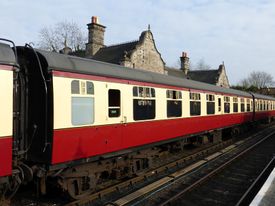BR 4345 Tourist Standard Open
| BR 4345 Tourist Standard Open | |
|---|---|
 BR Tourist Standard Open 4345 | |
| Built By | BRCW |
| Status | In use |
| Number | 4345 |
| Other numbers | M4345, GE4345 |
| History | |
| Built | 1957 |
| Diagram | 93 |
| Lot | 20207 |
| Type | TSO |
| Seats | 64 standard |
| 1988 | Arrived on SVR |
Contents
Contents
Service
4345 was built by BRCW in 1957 to diagram number 93 of lot number 20207. In service it carried the numbers M4345 and GE4345, signifying allocation to BR’s London Midland and Great Eastern lines.[1]
In 1985, 4345 and class mate 4593 formed part of the GW 150 exhibition set used by BR, for which they received commemorative tables and other modifications to the interior decor.[2]
Preservation
4345 and 4593 were selected as the best of a number examined at Carnforth, and both arrived on the SVR from there on 16 and 22 March 1988 respectively. At the time they were intended as replacements for two other TSOs, 4399 and 4584,[3] although in the event 4584 was retained until 1995 while 4399 is still resident on the SVR.
4345 received a repaint at Kidderminster on arrival, retaining the BR(W) chocolate and cream livery which it had carried in the Exhibition train.[4] It remained in this livery until April 1994 when, at the request of owners the Arley Station Fund, it was repainted into BR crimson and cream livery during a three month overhaul in Bewdley Paint Shop.[5]
4345 was used between 1995 and 1997 in the filming of the BBC comedy series Oh, Doctor Beeching! along with BSO 9220, RMB 1853 and Ivatt 2MT 46521.[6]
On Monday 28 September 2009, 4345 was the coach next to LMS 43106 when the locomotive’s tender became derailed at Hampton Loade. One of 4345’s buffers was trapped under the derailed tender and had to be removed on site. Other damage to 4345 was relatively minor, although the steam heat shut-off cock on the buffer beam was smashed to pieces while the buckeye coupling and draw bar were also affected. Repairs were carried out at Kidderminster in time for the carriage to be available for traffic the following weekend.[7]
As of 2017[update] 4345 is normally used in the BR Crimson & Cream running set.
See also
References
Links
| ||||||||||||||||||||||||||||||